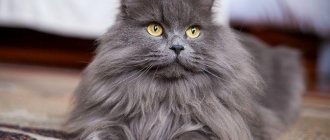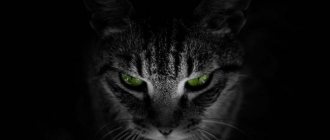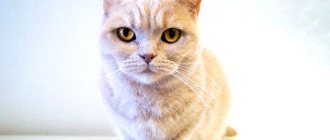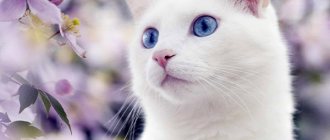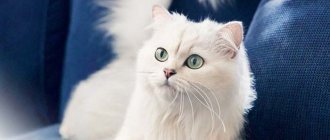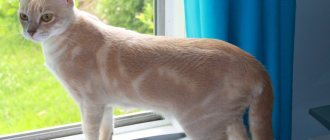In cat colors, white is presented in different variations from minimal, in the form of single hairs, “slippers”, “tie” to a completely white animal. Externally, only the area of its distribution is assessed.
The presence of white depends on the influence of three different genes, which do not necessarily have to be present simultaneously in the animal. At its core, it is not a color; it is more correct to talk about its absence or camouflage. In other words, white does not allow the main color to appear or the animal completely lacks pigment.
For a correct understanding, you need to know about the fundamental genetic differences between white cats. Completely white cats have a dominant white gene in their genotype, which prevents the main color from appearing. If an animal has white from single spots to almost complete color with colored areas, then this is due to the white spotting gene. Albinism, or the complete absence of pigment, is influenced by a gene that distributes color throughout the animal's body. Three different genes are located in different loci and have their own characteristics of external manifestation.
The dominant white and white spotting gene are located in a different locus in relation to the genes for black or red colors, therefore they are epistatic
.
They manifest themselves according to the principle of epistasis
, when a dominant or recessive gene affects another dominant one located in a different locus and completely or partially overlaps it. The albinism gene is recessive and manifests itself only in the homozygous recessive genotype.
White cat breeds
The color of cats is characterized by a wide variety of shades and patterns, but pure white cats are quite rare. To form such a color, the presence of a specific gene is required that hides all other colors in the genetic makeup of the animal.
White pets may belong to a specific breed or be a mixture of several. Their fur can be both long and short, and their eyes are colored predominantly in light colors.
If you decide to definitely get a white cat, below are 10 breeds among which these amazing animals are found.
There is a link between white cats with blue eyes and deafness, although not all pets with this combination are deaf. If you are the owner of a hard of hearing animal, help your furry friend - do not let him outside the apartment and teach him to use visual signals and vibrations in the process of communication.
Top best gray cat breeds
The most famous representatives of gray cats are the British, Scottish, Persian, and Russian blue cats. In addition, a similar color is typical for breeds such as Chartreux, Nibelung, Korat, American Curl, and Egyptian Mau.
Chartreuse
The Chartreuse is a beautiful cat with short printed hair, quite capricious and jealous in nature. Chartreuse is characterized by a blue color without admixtures of other shades.
The animals are large and have a natural, non-hybrid appearance. The iris of the eyes changes as they grow older: from blue in babies, to gray in young animals and orange in mature individuals.
Nibelung
The Nibelung is known as the “child of the mists” and looks like a Russian blue cat. The coat is semi-long, beautiful, glossy. A distinctive feature of the breed is its silent meow.
The coat color is plain gray with a silver tint. The nose is gray with a blue tint, the paw pads are pink.
Scottish lop-eared
The Scottish Fold is an adorable creature with a round head and drooping ears that make it look like a ball. Uneven coat color and colored patches are considered a defect. Gray colors come in silver chinchilla, blue merle, van, double, tabby, merle.
The eyes are expressive, round, copper, amber, orange, gray and blue.
There are two types of “Scots”:
- scottish fold shorthair - with plush fur;
- scottish fold longhair - long-haired.
British
The breed is characterized by 200 shades, but gray is considered the main one. Uneven color distribution, patterns, blue tabby, chinchilla, shaded color are considered a defect. The iris can be copper, lemon, or orange.
The “British” are well-mannered, independent, calm, do not like to be imposed on, prefer solitude.
Persian
For Persians, gray color is typical. Gray color can be pure, smoky, blue. There are also other colors - silver-black with a marble pattern, as well as a “butterfly” spot on the shoulders. Other shades of gray: silver-blue marble, silver-chocolate marble, silver-lilac, blue marble.
All varieties have bright yellow, green, blue-green irises.
The light-colored coat is evenly colored along its entire length. Of particular value are: solid lilac, blue marble, bluish-smoky shades.
Turkish Angora
The blue angora color was recently developed. Light shades are preferable. The hairs at the base should be darker. The paw pads and nose are combined with the main tone of the coat.
Turkish Angoras are calm in nature and prefer solitude. The breed is suitable for people leading a sedentary lifestyle.
American Curl
The breed is characterized by a gray coat color: silver tabby with marbled and spotted patterns, blue smoky.
A distinctive feature is the unusual shape of the ears. The shells are curved in the opposite direction and have hard cartilage.
By nature they are curious and devoted, active and sociable.
Ragamuffin
Ragamuffin is a stunningly beautiful cat with a fluffy coat of light gray color and light spots. A yellow and green iris is considered a marriage. The eyes should be blue.
By nature, they are affectionate and friendly creatures, devoted to their owners, loving children.
Egyptian Mau
Representatives of the breed are characterized by a silvery-smoky color with a spotted pattern. By nature, Mau are closed and distrustful.
Australian smoke
The color has three components: the main background, a dark pattern and haze. Marbled and spotted colors are available.
By nature, cats are friendly and affectionate, love children, and do not scratch or bite. They are easy to train and can perform various tricks.
Asian smoky
A smooth-haired cat with a light gray coat color and a light undercoat. The iris is amber or yellow.
By nature, animals are obedient, affectionate, balanced, cannot stand loneliness, and love space. They know how to express love and gratitude.
Bramble
An interesting breed of gray cats with coarse hair, a long body and tail, large ears and almond-shaped eyes.
By nature, cats are affectionate and playful, easy to train, and have a strong hunter instinct.
California radiant
A stunning beauty with leopard print on a yellow or silver background. The coat is short, soft, silky, pleasant to the touch. By nature, the animals are non-conflict, calm, and friendly.
American Bobtail
A cat breed with a short tail from birth. The body is massive, strong, the head is square. A common color is agouti. Cats love noisy companies and communication with people.
Norwegian forest
“Norwegians” are large and muscular cats, with long limbs, water-repellent fur, a fluffy “collar” and funny “pants” on the hind legs. One of the acceptable colors is gray tabby.
Ojo Azules
The variety of colors of Ojo Azules is amazing. Breeders counted more than 300 possible options. Including silver. The animal's eyes are large, expressive, and blue. By nature, cats are calm, do not like noisy companies, have high intelligence, and are amenable to training.
American Shorthair
Representatives of this breed are relatives of domestic shorthair cats. They are distinguished by their friendliness and calm character. A cat's "fur coat" comes in a variety of colors and patterns, including plain white.
American Shorthairs easily adapt to different living conditions. They prefer to spend time with their beloved family members, but are also able to entertain themselves with interactive toys.
Breed overview
- athletic build;
- short thick fur.
Devon Rex
Large eyes and prominent cheekbones make the Devon Rex look like a cartoon character. This cat's short, wavy coat can be colored white or other colors.
Representatives of the breed are active and playful. They are friendly in nature, making them suitable pets for families with children and other pets.
Breed overview
- big ears;
- thin neck;
- prominent eyes.
European Shorthair
This breed is one of the oldest and most widespread in Europe. In addition to white fur, cats can come in a variety of colors and patterns, and their eyes are most often amber, blue and green.
Representatives of the breed are affectionate, playful, intelligent and thrive in a variety of living conditions.
Breed overview
- stocky, muscular body;
- short and thick coat;
- round muzzle.
Maine Coon
Known for their thick, long hair, cats come in a variety of colors, including tortoiseshell and striped. Traditionally, the Maine Coon's coat is brown-striped.
These cats are friendly to everyone and get along well not only with family members, but also with strangers, as well as with other pets.
Breed overview
- stocky, muscular body;
- thick and heavy wool.
Serengeti
Slender, very graceful, quite large, long-legged cat, with a small head on a long neck and very large ears located high. The Serengeti has a friendly and sociable character; such a pet will find the strength to play with all family members.
This will seem strange, but the goal of the breeding work of Serengeti breeders is the same as that of Savannah breeders - maximum resemblance to the appearance of the serval. Only these robots are built completely differently: without involving wild animals, but by mating Bengals and Orientals. Today the breed has not received full recognition and has a preliminary status - the Serengeti can participate in exhibitions, but does not receive titles.
Oriental
Slender and athletic, Orientals can come in a variety of colors, including plain white. These animals are active, talkative, attractive and love attention. Some pets become so accustomed to people that it can be difficult for them to accept being separated from any family members.
Breed overview
- smooth body;
- angular head shape;
- big ears;
- almond-shaped eyes.
Ocicat
An elegant, slender but muscular cat with a well-proportioned head and large ears. Ocicats are descendants of Siamese and Abyssinians, therefore they are sociable, playful and inquisitive. Nobody planned to breed them: the first Ocicat appeared in a Siamese cattery and became a considerable surprise for the breeder.
The fact is that she wanted to diversify the colors allowed by the standards of the Siamese breed (in the 60s of the last century such experiments were more tolerant). And she attracted Abyssinian cats for mating. And one day she received a magnificent spotted kitten, which did not at all live up to her expectations. However, the idea of creating a new breed came to her only after she told a famous geneticist about the unusual kitten.
Persian
The color white is often associated with Persian cats, although they come in a variety of colors and patterns. Their long, flowing coat requires careful grooming, which includes daily brushing and removing matted areas.
Persians are sweet and easy-going pets who prefer to be in a calm and predictable environment.
Breed overview
- long wool;
- short and strong legs;
- Round eyes.
Siamese
Siamese cats, which are called "foreign whites", do not have the usual dark spots on the body of the ears, face, paws and tail. Moreover, all representatives of this breed are born completely white, receiving the traditional color as they grow up.
Siamese love their family members and prefer to be the center of attention. They are overly “talkative” and enjoy using their voice to tell their owner about their needs.
Breed overview
- smooth body;
- almond-shaped eyes;
- wedge-shaped head.
Breeds of long-haired gray cats
List of longhaired gray cat breeds:
- British Longhair;
- Nibelung;
- Persian;
- Burma;
- mandarin;
- Kurilian Bobtail;
- Javanese;
- Japanese bobtail.
Shorthair
List of shorthaired blue cats:
- British Shorthair;
- Scottish fold and straight-eared;
- Egyptian Mau;
- Russian blue;
- korat
Bald
Hairless breeds have no hair on the body, only velor fluff is possible. The gray color appears only on the skin and is observed in such breeds as: Dwelf, Elf, Canadian Sphynx, Peterbald, Doskoi Sphynx, Bambino.
Siberian
Strong and agile, Siberian cats have a 3-layer thick coat that can come in a variety of colors and patterns. Their thick coat needs regular brushing (twice a week and more often during molting).
These pets love adventure. They can often be seen climbing onto all sorts of surfaces, which pets conquer during play or for research purposes.
Breed overview
- stocky build;
- thick coat.
Turkish Angora
The Turkish Angora is a natural breed that existed in Turkey several hundred years ago. These cats are often depicted in white, although their colors can be black, blue, red, etc.
Turkish Angoras are energetic, assertive, and require stimulating play to maintain a positive emotional state.
Breed overview
- muscular body;
- long paws;
- thick “fur coat”;
- almond-shaped eyes.
Turkish van
In most cases, these cats have white fur with colored spots on the head and tail.
They are active - they love to run, jump, play, and are also known for their desire to swim. Turkish Vans do not like to spend time in people's arms, but they do not mind being stroked and try to be close to their beloved owner.
Breed overview
- agile, muscular and long body;
- medium length wool.
Cat breeds
Each breed of animal is determined by specific features in appearance and character traits that are unique to it - this is called the breed standard, which must be recognized by various organizations of felinologists (TICA, FIFe, WCF, CFA, IFA, ICU, WACC, etc.) for each of them own rules of recognition. All purebred cats are given pedigrees.
One of the most amazing and mysterious breeds is the Maine Coon - a gentle giant with a serious look. These creatures are called “indoor lynxes,” which is not surprising, because... they are one of the largest domestic cats.
All over the world this breed is called “Scottish Fold”, but we are more accustomed to calling these cute cats “Scottish Fold”. Their “cute” appearance will not leave anyone indifferent - you immediately want to pick up such a creature and cuddle it.
Millions of people around the world cannot imagine their existence without such “plush” bundles of happiness. These aristocratic, friendly, charismatic and very clean pets have long been one of the most popular cat breeds on the planet.
Bengal cats are incredibly beautiful animals that combine the spectacular appearance of wild predators and the docile nature of pets. Well, the main “feature” of these creatures is their “leopard color,” which is why they are called “domestic leopards.”
Siamese - graceful oriental beauties and beauties (who managed to preserve their roots almost in their original form) stand out for their special grace, temperamental character and a certain diminutiveness.
Among the many breeds, there is one endowed with incredible elegance and grace - this is the Abyssinian cat - an intelligent, flexible and dexterous creature. There is a certain mystery and special sophistication in her, and her appearance is called “divine.”
This breed is distinguished by its special silver-blue color and piercing green eyes. Russian blue cats are “real noblewomen.” These are graceful and mysterious creatures, delighting their owners with a playful but obedient disposition.
Siberian cats are considered real Russian beauties for their expressive eyes, chic “fur coat” and friendly character. They have long won the hearts of many cat lovers... a very long time ago - the first mentions of them are found in the 16th century.
The Oriental cat, at first glance, is impressive with its ears (in comparison with the body and head, they seem simply huge). This is a wonderful friend and you cannot betray him (the cat will not understand if you give it to another person).
Charming “Siberians” with a “Siamese” color, a chic hypoallergenic “fur coat” and an easy-going disposition are the pride of Russian felinologists from the banks of the Neva... Dmitry Medvedev got himself a kitten of this particular breed, and Vladimir Putin gave one to the Prime Minister of Japan.
Source
Savannah
A very elegant, graceful, rather large cat on high legs, with a small head on a long graceful neck, and huge, high-set ears. Savannahs are very smart, active and friendly cats.
This breed, like the Bengal, was bred through interspecific crossing (domestic cat and African serval). But, unlike the Bengals, no one was going to take them out. It all started with the fashion for servals in the 80s in the USA, and the unusual spotted pet could be bought in one of the nurseries. In one such nursery, an accidental mating of the owner's cat and a breeding serval occurred, from which a female kitten was born, named Savannah. She could not help but interest the breeders, and after some time it was decided to create a new breed, named after its first representative.
Why is a cat born white?
Three genes are responsible for the purity of the snow cat color - albinism “c”, white color W and piebaldity S.
- From a scientific point of view, an albino cat is completely colorless, since its genetic makeup contains the “ca” gene, which characterizes the complete absence of pigment in color. A pure albino with a red iris is very rare. Albino with blue eyes, not very bright, is more common in the cat world. The “c” gene is responsible for the coloring of such an animal.
- If a female, a carrier of the dominant white W gene, is crossed with a representative of a different color, then the kittens in the litter will repeat the color of the mother. When two W carriers are combined, the offspring can be of any color. These animals have bright blue or blue eyes, but they are also found with topaz or green irises.
- The S piebald gene is characterized by solid white spots in the color of the animal. Visually, the cat is perceived as a clean, even, snowy shade. If these spots do not merge, other colors are present in the color. Eye color blue, yellow, green.
Norwegian Forest Cats are white
Genotypes of animals with the white spotting gene
WSWS
– most often the color is van or harlequin, where white occupies the maximum part of the body surface, the main color is presented in the form of a cap on the head, a fully colored tail and single spots on the sides or back. An animal with this genotype can be completely white.
WSwS
– most often the color is bicolor, where white occupies up to 60% of the body surface; a white belly, chest, neck and an inverted V on the face are required. When crossing two bicolors, any options for the amount of white are possible (van, harlequin, bicolor, no white).
wSwS
– absence of white in color.
In addition, there are colors with white, not associated with the white spotting gene, but externally similar to its manifestation. These mutations occur spontaneously and may appear as the animal matures. Of the latter, Finnish, tweed, and Carpathian mutations are known. Age-related progressive loss of pigment – vitiligo (leukoderma), leukotrichia.
Color and deafness
Many white cats are deaf due to inner ear degeneration. Geneticists studying these animals have determined that their deafness depends on eye color:
- 17-22% with eyes of any color except blue;
- about 40% are heterochromic (i.e. with different colors);
- 65-85% with blue eyes.
In cats with different eyes, hearing loss is usually observed on the side of the blue eye.
Kao-mani with blue eyes
The cause of deafness is in the dominant W gene. After much research, scientists have determined that it is pleiotropic - it is responsible for a number of traits in the genotype - not only for coat color, but also for deafness and blue-eyedness. By the way, you can also read about blue-eyed cats and breeds on our portal.
The dominant W allele disrupts the migration of melanoblasts—pigment producers and transporters—and also affects the activity of other cells in the area of the neural tube of the embryo
Deaf cats are excluded from the breeding program. And as a pet, they can live as absolutely full-fledged individuals; the lack of hearing is compensated by other senses. True, such animals will not survive on the street.
Bengal
Of course, this is the first of the spotted cat breeds, although the standards allow merle colors (by the way, very striking ones). But the Bengal spots, called rosettes, are very beautiful - after all, they are surrounded by a spectacular dark border.
And the Bengals themselves are good: athletic, muscular, with a small head, neat ears with rounded tips. Another interesting feature of the breed is the specific shine of the coat, the so-called glitter effect. Some hairs are transparent and shine in the sun (or light). It feels like the fur is shining.
This is the oldest and most famous breed, obtained through interspecific crossing (of a domestic cat and an Asian leopard cat). Of course, it is much more difficult to breed such a breed: it took its creator, J. Mill, 30 years.
White cats
Many cat breeds are white. But there are also those for whom this color is a distinctive feature.
Khao-mani
This breed came to the world from Thailand. Translated from Thai as “white gem”. In English-speaking countries it is often called "Diamond Eye". Snowy fur and heterochromia are the distinguishing features of these cats.
This ancient variety is mentioned in the manuscript "Book of Poems about Cats." For many centuries, she could only be a pet of the royal house.
Kittens are often born with a dark spot on their head, which usually disappears with age. But sometimes there are individuals that are not pure white, spotted. Eyes can be of different colors - amber, green, blue. Heterochromia is rare. Approximately half of animals suffer from hearing loss in one or both ears.
By nature, these are active, cheerful and energetic pets, they love to “talk”. They are very trusting and good-natured, strongly attached to their owner. The price for a kitten is very high - 600-900 pounds sterling. These animals are very rare.
Foreign white
These pure white cats are the result of genetic selection and inbreeding of common Siamese. The peculiarity of this breed is that with snow color and blue eyes, kittens are never born deaf.
Genetics believe that this trait is due to the long isolation of the Siamese from other species, the purity of its line, because hearing loss first appeared, most likely, from the Angora.
In English, "foreign white" means "white foreigner". The breed was registered in 1966 in Great Britain. By nature, these snow pets are true Siamese. The cost of kittens from the nursery is 35 – 50 thousand rubles.
Balinese
This long-haired Siamese is the result of a natural mutation. At first, such kittens were discarded, then breeders decided to consolidate the “rejection” factor and separate these animals into a separate breed, registered for the first time in 1965.
They have a characteristic color-point color - a light main background (usually white) and dark points. Although there are also completely white ones. The cost of kittens starts from 15 thousand rubles for a pet class.
Turkish Angora
The oldest breed almost completely died during the Second World War. It was restored in the middle of the last century from a pair preserved in the Ankara Zoo.
Did you know that the incredibly beautiful white Angora can often be aggressive if mishandled, and also willful? Read about this, as well as other “evil” cat breeds, on our portal Mister Cat.
Semi-long, dry and thin, crumbly wool comes in different shades, but it is generally accepted that the original color was white. Such animals are most often found in nurseries. Their eyes are blue or heterochromic.
These pets have an easy-going and good-natured character, are curious and active. They easily and quickly become attached to all household members, including other animals. The cost of kittens is 350-600 dollars.
Russian white
By crossing a Russian Blue and a snow-colored Siberian cat, we got a short-haired white cat with green eyes. This is a quiet, gentle and affectionate animal, very attached to its owner.
Currently, this breed is recognized in Australia, New Zealand, South Africa, and is registered as experimental in Europe and the USA. There are no such cats in Russia.
Turkish van
This long-haired individual has a snow-colored main body, rare colored spots on the tail, paws, and head. Eye color blue, amber, green. The cost of a kitten is from four hundred to a thousand dollars, depending on the class.
Anatolian cat
This is a naturally occurring animal. Most likely a type of Turkish Van, but with short hair. The colors are numerous, pure snow-white and white with spots of red and other colors are found. Albino type is not allowed. Heterochromia is inherent. The price for a kitten from nurseries starts from one and a half thousand dollars.
Persian cat
The snow-white representatives of this long-haired line with a soft undercoat also have a typical eye color; preference is given to animals with different eyes. The cost of kittens is from five hundred to one and a half thousand dollars, it depends on the class.
British
White Britons are no different from their counterparts, except for the color of their coat and eyes, which are either blue or heterochromic. These pets are calm and somewhat phlegmatic. The cost of pet-class kittens is from 15 thousand rubles.
Scottish lop-eared
Among the Scottish Folds, which differ from the British mainly by having folded ears, there is also a solid white color, blue eyes or heterochromia.
Himalayan cat
This is a color-point Persian, the main color is white, the mask is usually cream. The cost of a kitten is from five hundred to one and a half thousand dollars, depending on the class - pet, breed or show.
Devon Rex and Cornish Rex
Funny kids resemble a shorn lamb with slightly curly hair. Snow-white, blue-eyed pets are rare. The cost of such kittens is from five hundred to a thousand US dollars.
Oriental
Absolute snow without yellowness with green, topaz or blue eyes is considered a special color. There are different-eyed individuals. Such unusual kittens can be purchased for prices ranging from four hundred to a thousand dollars.
Snow Bengal
Bengals, even snow-colored ones, still have spots or streaks on their short, shiny coat. There are three types of snow:
- Lynx is the snowiest shade, even the spots are almost invisible. The eyes are bright blue. Heterochromia and deafness never occur.
Features of gray cats
Gray cats are real aristocrats. Calm, noble, non-aggressive. Animals love their owners, although they do not always show their feelings. In addition, silver cats are not vindictive at all.
Blue cats are independent and slightly proud. From the first day in a person’s home, they try on the role of owner. Owners sometimes feel that they are the ones living in the purr’s territory, and not vice versa.
Kittens have a playful disposition, but as they grow older, cats become quite withdrawn, prefer to keep their distance and only approach a person when they need something. For example, they loudly signal that it is time to eat.
Blue cats are very intelligent, curious, and extremely loyal to humans. Some animals like to sleep on their owner's lap, but there are also those who simply lie down next to them because they do not like tight hugs.
Loneliness does not frighten gray cats. They will always find something to do. Moreover, their aristocratic manners do not go away; often representatives of this color do not stoop to mischief.
Genetics of gray color
The color of a particular breed is determined by various combinations of recessive and dominant genes. The dominant gene, which is responsible for white and black colors, acts as a recessive gene. From a genetic perspective, gray color looks like this: the dominant black gene B is diluted by the recessive light gene d. Under the influence of the second, the dark pigment zumelanin is distributed unevenly in the hairs. The granules stick together, and white spaces appear between them, creating a lightening effect. Accordingly, the more black pigment, the darker the color of the cat’s coat, and vice versa.
Reference. Sometimes, due to a mutation, the black pigment is concentrated at the base of the hair, while the tip remains light.
To achieve a solid color, kittens must inherit the agouti gene, which is responsible for the absence of a pattern, and the lightening gene. It is worth noting that the gray shade does not contain red pigment. In addition, there is a lilac color, for which the “red” gene is responsible. These individuals have a warm fur coat.
Advantages and disadvantages
Advantages of gray cats:
- peacefulness;
- equilibrium;
- lack of aggression;
- attractiveness;
- affectionate disposition.
Blue cats probably have no disadvantages. Perhaps some owners want their pets to be more willing to respond to affection. However, it all depends on the breed and temperament of the animal. Some people also don't like being cuddled and prefer to keep their distance. At the same time, no one is indignant.
What happens if you have a white cat at home?
There are many superstitions about white cats. People believe that they absorb negative energy, protect against the evil eye, and protect from illness and trouble.
- If a white cat crosses the road. It is believed that if a black cat crosses a person’s path, then misfortune awaits the latter. This belief exists in many countries. A white cat in this case, on the contrary, promises good luck. In Ireland, it is believed that you need to say hello to her, and if Snow White answers, then this is a sign of an imminent win or major success.
- White cat in the house. In many countries, it is believed that with a white cat good luck in business and prosperity comes to the house. Especially if it is a pet with one blue eye. If such a female gave birth to snow-white kittens, then well-being is guaranteed forever. In England, on the contrary, if a strange white cat enters the house, financial losses lie ahead. As soon as he comes out, he will take with him luck and money.
- How to behave around white cats. The British never offend their snow-white pets - otherwise you will bring misfortune on yourself. You need to pet the cat, treat it with a treat, and then the day will turn out great.
- See it in a dream. A dream involving a snow-white beauty promises a woman an early pregnancy. Another superstition is that she needs to pay attention to her children.
- White wool. Touching the long white wool in Albania means that you will soon get better, gain weight, and for a woman, you will soon become pregnant.
- White cat and marriage. If a person finds owners for seven white kittens, then his personal life will soon develop. In this case, women must accommodate females, and men - males. Newlyweds who meet a white cat along the way need not worry; their family will be strong and happy.
- Bad luck. Interestingly, in the countries of the Middle East everything is exactly the opposite. If a white cat crosses the road, especially at night, there will be trouble.
- Child and snow-white cat. North American Indian beliefs prohibit keeping a white cat in the house if there is a baby in the family. And in the Mediterranean countries, an animal of this color in the house is the key to a future happy life for the baby.
All these signs, of course, have no scientific basis.
Features and genetics of color
The coat looks gray with unevenly distributed black pigment. If you look at a hair under a microscope, you can see that there are white spaces between the black areas. The amount of carbon pigment in the bulb itself does not affect the color: gray cats have the same amount of it as black cats. An ashy shade is obtained when eumelanin fills only part of the pigment cells of the hair, and some remain uncolored. In this case, filled and empty cells alternate not one at a time, but in small clusters. The ratio of the sizes of the white and black zones on the hair determines how light the shade will be.
If the light area is at the tips of the bristles, a silvery tint appears in the color.
Gray cats are carriers of the dominant black gene. Genetically, their difference from black cats is not associated with the white gene - this gene is the strongest of all, and if it is dominant, regardless of the set, a white kitten is born. The difference in color is due to the color density gene. Being dominant, it determines uniform staining of cells and vice versa. That is, in gray cats, unlike black cats, it is recessive.
A solid gray color, without spots or stripes, is called blue. It is possessed by cats that do not have the dominant agouti gene that determines the pattern. The eyes of these cats are usually brown, yellow or green. The nose and pads on the paws often have a gray-blue tint.
If the genes for black color and density turn out to be recessive, and there is no dominant red gene responsible for the orange pigment (pheomelanin), the gray coat color will have a warm tone. This color, if solid, is called lilac.
The undercoat of gray wool can be light, even white. This gray-white cat has a smoky coloration.


